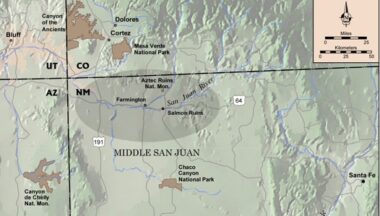“Chacoan Immigration and Influence in the Middle San Juan” – Paul Reed

The identities and origins of the builders and inhabitants of Chacoan outliers have long been the subject of debate, particularly in the Middle San Juan region to the north. Did immigrants from Chaco Canyon establish these outliers as colonies, did local groups emulating Chacoan ideology build these settlements, or did both groups build and co-reside within them? Together with its partners, Archaeology Southwest has recently completed research on a National Science Foundation-funded project entitled: Chacoan Expansion or Emulation of the Chacoan System? The Emergence of Aztec, Salmon, and Other Great House Communities in the Middle San Juan (Reed 2011a). Project team members investigated Chacoan influence and presence in the Middle San Juan region through exploration and analysis of architecture, settlement patterns, and ceramic and perishable artifacts (Brown and Paddock 2011; Clark and Reed 2011; Washburn and Reed 2011; Webster 2011; Reed 2011a, 2011b). Team members made use of specific methodologies to distinguish between low- and high-visibility attributes. These attributes, in turn, allowed for probable determinations of Chacoan or local origin for great houses, architecture at various sites, and various classes of material culture on Middle San Juan sites. In addressing the primary research question, team members found evidence both for migration of Chacoan builders and colonists to the Middle San Juan and for emulation of Chacoan great houses by local residents.
Whether Chaco comprised a single socio-ethnic identity or a more complicated society described here as a transcendent meta-identity, a diasporic community model may be useful as a competing hypothesis to a colonization model in explaining the migration process from Chaco Canyon to the Middle San Juan and other areas of the northern Southwest (Clark and Reed 2011). If the main centers in Chaco Canyon were depopulated before outlier settlements, Chacoan roads that connect the latter to the former argue for a dispersed population that maintained a diasporic community based on shared identity and lost homeland. The colonization-diaspora dialectic leads to important research questions such as: how planned was the migration process from Chaco and who planned it; what motivated this movement; and how was it organized? These questions require a valley-by-valley assessment in the Middle San Juan.
Chacoan immigrants were probably minorities in many of the valleys in which they resettled, including the Animas and La Plata Valleys in the Middle San Juan. However, the ideological power of Chacoan immigrants amplified their impact far beyond their numbers. This is evident in the production and exchange of Cibola White Ware types such as Chaco and Gallup Black-on-whites, the construction of great and “good” kivas and houses, and the reproduction of ritual paraphernalia. Chacoan immigrants attempted to reconstruct idealized Chacoan communities in numerous locations with variable success as local groups differentially adopted Chacoan ideology and accepted these immigrants. Immigrant descendants and local groups who bought into Chaco transformed its meaning through time. Furthermore, the Chacoan meta-identity persisted for centuries with traces surviving in many contemporary Puebloan societies.
In this presentation, I’ll emphasize a bottom-up approach that carefully examines the archaeological record of each river valley in the Middle San Juan region — Animas, San Juan, and La Plata — when considering these questions (Reed 2011b). I’ll discuss the methods that have been successfully employed elsewhere in the American Southwest to identify immigrants and reconstruct local-immigrant interaction. These concepts have provided significant insights as we have sought to explain the “Chaco Phenomenon” and its unique expression in amidst the complex cultural history of local-Chacoan interaction in the Middle San Juan.
 All Posts
All Posts